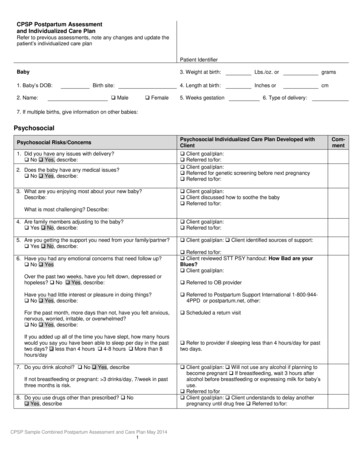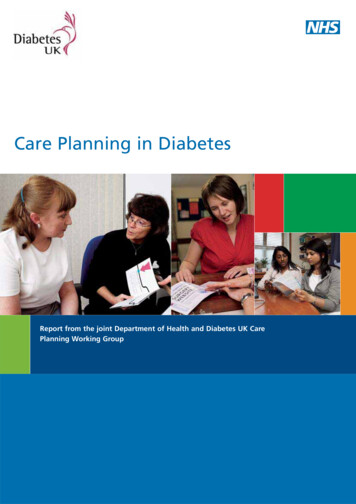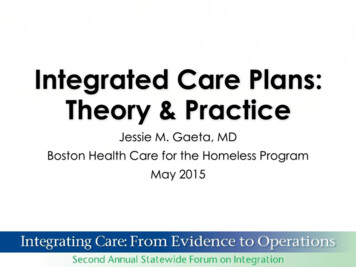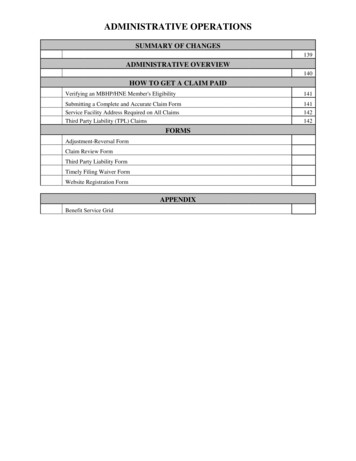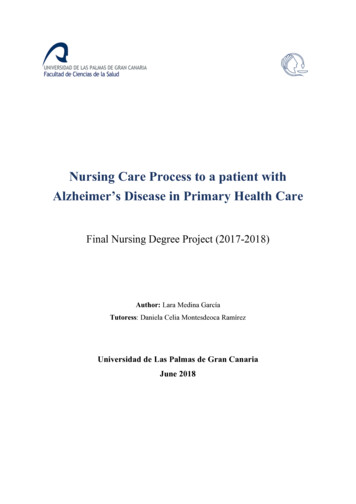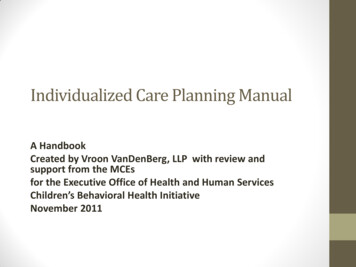
Transcription
Individualized Care Planning ManualA HandbookCreated by Vroon VanDenBerg, LLP with review andsupport from the MCEsfor the Executive Office of Health and Human ServicesChildren’s Behavioral Health InitiativeNovember 2011
Purposes of the Manual Provide a description of the documentation process in thecontext of high fidelity wraparound that meets Medicaidrequirements Provide a revised version of the Individual Care Plan (ICP) thatbetter marries high fidelity wraparound process and Medicaidrequirements Provide samples of an integrated comprehensive assessmentthat meets MCE and high fidelity wraparound requirements(this is not a prescribed format) Provide plans for preventing or reducing crisis based on afunctional assessment that fit within the ICP document Provide a sample of an optional medication management plan Provide a description of documenting the ongoing ICP process Provide a description of how transition from wraparound canbe documented
Contents of ManualChapter OneChapter TwoChapter ThreeChapter FourChapter FiveChapter SixChapter SevenChapter EightChapter NineManual OverviewInitial Engagement and Initial Safety PlanComprehensive AssessmentPreparing the Family andEngaging and Preparing the TeamInitial Individual Care Plan ProcessInstructions for Completion of ICP FormPsychotropic Medication PlansDocumenting the Ongoing ICP ProcessDocumenting Transition
Appendices to ManualAppendix AAppendix BAppendix CAppendix DAppendix EAppendix FSample Comprehensive AssessmentSample Initial Individual Care PlanSample Medication Management PlanSample Full Year Documentation of ICP andProgress NotesSample Agendas, Handouts, MeetingMinutes and Current ICPs for FamiliesSample Transition Documents
Care CoordinationIntensive Care Coordination(Wraparound)Familiesdecide onmost appropriateinitial serviceindependentlyor in consultation withhelping professions Clinical Assessment SED determination for eligibility Medical Necessity determination Care coordinationIn-Home Therapy Clinical Assessment Medical necessity determination Care coordination available BehaviorManagementTherapy &MonitoringOutpatient Therapy FS&T(Family Partners) Clinical Assessment Medical necessity determination Care coordination availableEmergencyServicesMobile hcore clinicalservicesChild may have 1,2, or all 3 core servicesCare coordination provided by most intensiveservice received. TherapeuticMentoring5
The Problem of Engagement inBehavioral Health Services National Health Survey (2008) finds that over 70% offamilies with a child with severe emotional disturbance(SED) have not successfully completed a behavioral healthservice The primary determinant of successful completion is fullparental engagement and The low rate of successful completion shows a generalfailure to fully engage families in the process and services Intensive Care Coordination (Wraparound) is the mostintense level of care in CBHI and thus often are thefamilies who are the hardest to engage. This takes time, flexibility, patience, and persistent effortsto engage them through multiple means
Research on EngagementFamilies tell us that there are a number of factors that reduceengagement in the process including Not feeling listened to Past bad experiences with professional staff and experiencesreported by other families Treatment goals and plans that do not address the things thatare most important to the family and thus feel irrelevant Treatment approaches that do not match the family’s culture In addition, when treatment is provided without full parentalengagement many of youth who do show progress andcomplete a service component do not have lasting progress
Families raising youth with mental health issuesoften feel J Anthony Irsfeld
Comprehensive Assessment Five Axis Diagnosis Based on the DSM IV-RDetermination of a Serious Emotional DisturbanceCANS ScoresFull Family examination of needs across life domainsExamination of family strengths and cultureInput from other professionals currently working withthe youth and family Development of a family owned vision of their future Identification of 2 or 3 needs the youth and family wantto address first Detailed description of strengths and culture related tothese needs
Medical Necessity The youth meets the criteria for serious emotional disturbance a. needs or receives multiple services other than ICC from the sameor multiple provider(s)OR b. needs or receives services from, state agencies, special education,or a combination thereof;AND c. needs a care planning team to coordinate services the youthneeds from multiple providers or state agencies, special education,or a combination thereofThis is a partial description of Medical Necessity -targetcase-mgt-services-icc.pdf
Strengths, Needs, Culture Discovery An ongoing documentThis can be seen as a narrative of the processFocuses on strengths of all family membersTies back to, and expands on the needs in all life domainareas including those identified in the CANS Develops a Vision the Family can be committed to(Critical for Engagement) Prioritizes the Needs from the Family’s and LegalMandate point of view (Critical for Engagement) Sets the ground work for the ICP (identifying strengthsand culture related to the prioritized needs)
The Family Vision Keep it positive View as the state (present tense) their family will reachwhen their concerns are met Incorporate the whole family View of the future the family wants and can own in theirown words (don’t worry about word-smithing it orforcing it into present tense) Can be updated but when done well this usually onlyhappens when conditions or needs change significantlyor How to address when meeting the vision does not bringthe family to transition
Timeline for Comprehensive AssessmentDetail on NeedsDiagnosisVisionCANS ScoresPriority Needs(10 Days)Strengths & Culture(25 Days)The clock starts counting when consent toprovide wraparound is receivedPrepare Familyand Team(prior to 1stMeeting)
Expert vs. Collaborative Approaches The Expert Approach: the responsibility for analyzing theproblem, figuring out the causes, and coming up withsolutions all rests with the professional (expert). Tends torely exclusively on professional knowledge. The Collaborative Approach: responsibility is sharedbetween the family and the professional(s). Both bringcomplementary knowledge (professional and experiential)and strive to combine them to generate positive change.J Anthony Irsfeld
Preparing the Family Planning meeting logisticsPlanning the agendaPreparing family for their rolesFinal selection of team members to start the processPlanning how to recruit and involve the teamEnsuring that the family has any needed supports15
Team Member Selection Family and youth select teamRequired members are ICC, Family and Representativeof Agencies with a legal mandate for the youthHelp understand importance of natural supportsAddress concerns about involving natural supportsUse flexible strategies including non attending teammembers and team members on specific issuesTry to get everyone providing services for youth on theteamMake every effort to ensure all selected participate onteam even if requires using flexible strategies16
Team Member Engagement and Prep Solicit team membershipOrient each team member to wraparoundIdentify potential concerns and howwraparound can help address theseElicit information about the strengths, needsand cultureShare highlights of family assessment andvisionPrepare team members for first meeting17
Planning (Initial Plan Development) Add strengths for family and all team membersSet team processReview the family long range visionReview team member concerns (concerns about thefamily, agency mandates and missions)Develop team missionPrioritization of needsSet initial goalsBrainstorm optionsFamily selects the ones that best build on their strengthsand cultureDevelop specific action plans18
ICP Document Ties back to the CANS and the SNCD to find prioritized familyvision, priority needs and related strengths and culture Goals are concrete statement of where the family will be inthe future. They do not have to be measureable Every goal must have at least one and sometimes moremeasureable short term objectives and specific measurementstrategies Detailed descriptions of strengths and needs proceedbrainstorming options Brainstorming many options use family voice and choice toselect two or three that will work Develop specific tasks and responsibilities with time lines toaccomplish options
Long Range Vision NeedsJoan is living at home and doing well at school. She andSam are getting along, they are not arguing and fightingin the apartment and the family enjoys spending timetogether.Joan is enjoying school more and is preparing for avocationJoan and Tammy, Tammy and Sam and the whole familyare having more quality times togetherJoan is not fighting or being aggressive at school and notfighting with Sam at home20
Individual Care Planning Individual Care Planning is Sequential notComprehensive meaning that it focuses on a few items ata time and unless there are legal mandates involving thefamily these should be selected by the family Each plan should focus on short manageable objectivesso the family can have a lot of success and thus buildtheir self efficacy Having short measureable short term objectives supportssuccess but also identifies when plans are not working alot sooner
ICP Document Ties back to the CANS and the SNCD to find prioritized familyvision, priority needs and related strengths and culture Goals are concrete statement of where the family will be inthe future. They do not have to be measureable Every goal must have at least one and sometimes moremeasureable short term objectives and specific measurementstrategies Detailed descriptions of strengths and needs proceedbrainstorming options Brainstorming many options use family voice and choice toselect two or three that will work Develop specific tasks and responsibilities with time lines toaccomplish options
Measurement and Objectives According to Eric Bruns, national vice-chairperson of theNWI, one of the most common errors in high fidelitywraparound is to not make objectives measurable – if wecan’t measure it, we don’t know if we have achieved it. Objectives are short term measurable goals that will beset for each prioritized need. Objectives are generally things that can be accomplishedin two weeks or less so the family and team cancelebrate often thus build self efficacy.23
Tracking Progress Measures Process Measures Outcome Measures Scaling24
Process Measures Measure “the doing” of wraparound Measure if the Phases and Activities are being done Track implementation goals about whether or notwraparound steps are occurring25
Outcome Measures Measures outcomes related to family and youth functioningand achievement of priority goals and objectives Tracks improvement May be quantitative or qualitative26
Scaling Tracks progress in achieving goals using a simple 1 to 10measurement scale (or 1 to 5) Scaling can occur prior to options going into place Scaling can occur during the time that wraparound plans arebeing implemented Scaling can occur as goals are being achieved27
ICP Document Ties back to the CANS and the SNCD to find prioritized familyvision, priority needs and related strengths and culture Goals are concrete statement of where the family will be inthe future. They do not have to be measureable Every goal must have at least one and sometimes moremeasureable short term objectives and specific measurementstrategies Detailed descriptions of strengths and needs proceedbrainstorming options Brainstorming many options use family voice and choice toselect two or three that will work Develop specific tasks and responsibilities with time lines toaccomplish options
Strengths & Accomplishments The more specific it is, the more meaningful it is for thefamily May be unique for each goal Can be used to show progress towards the goal
StrengthsGood in EnglishGood voice and likes to singRelationship with DA teacherLeader with young cousinsLikes to organize dramasLikes being read toShe enjoys writing and selfexpressionHas a brother and cousin who areinvolvedDA Teacher has willing to help JoanDA teacher involved with singingDA does dramas with youngerstudentsVFW buddies could help encourageSam to support JoanJoan is going to schooland enjoying it moreCulture Mother values education Whole family likes music,drama and story telling Mom is a self learner Joan has a goal (to be a singeror in plays) Rely on natural supportsversus professionals Family enjoys humor
Brainstorming There is no limit to number of optionsTry to aim for at least 10There are no bad ideas; make it non evaluativeBe creativeTry to get half focused on natural supports andcommunity resources
Joan is going to school and enjoying it moreSome type leadership in dramaGo to person in schoolSchool based safety planJoin the Drama ClubWrite songsSchool newspaperSchool social support skills groupPeer mentor to youngerWeekly sessions with school counselorPoetry clubLibrary volunteerRead to young kidsPlay an instrumentShe and her friend do homework togetherProject with Gaga and Beyoncé’Journal of Memorial for her FatherTeam meeting at school (to support her)Help the DA Teacher put on elementary playInvite VFW, uncle cousins to watch
ICP Document Ties back to the CANS and the SNCD to find prioritized familyvision, priority needs and related strengths and culture Goals are concrete statement of where the family will be inthe future. They do not have to be measureable Every goal must have at least one and sometimes moremeasureable short term objectives and specific measurementstrategies Detailed descriptions of strengths and needs proceedbrainstorming options Brainstorming many options use family voice and choice toselect two or three that will work Develop specific tasks and responsibilities with time lines toaccomplish options
ScheduleRulesEarnsDA TeachAsksHelps withDramaRolesTransHomework34Drama Arts Teacher, Principal, Rest of School Staffs
Crisis Plan(s) Are created by and for the family Best crisis plans are usually built on the knowledge andskills of the team but are unique for each family The focus of wraparound crisis planning is to break thecycles of crisis for youth and families Failure to involve the team may lead team members toact unilaterally and unintentionally undermining theprocess35
Crisis Plan(s) continued Based on a functional assessment Focus on predicting what leads to crisis or behavioralchallenges Includes prevention, early intervention, reactiveresponse and safety plan Teaches family the process36
During Implementation Ensure that people understood the plan Ensure that team follow through on plan and if notexplore the reasons Ensure that team had supports to implement Address problems with implementation quickly Monitored progress to Spot when plans needed to be changed Identify when to start new objectives Helped build team cohesion Began to plan for transition37
Implementation Plan Agendas Highlight strengths, accomplishments and contributions Review status of completion and progress on currentobjectives and plans Compare plan to vision and team mission Focuses the meeting on specific goals ICP goals Transition goals Progress Update the ICP form and add progress tracking
Progress Tracking Track every objective at every meeting Update CANS at least every 90 days and more often asneeded Update the comprehensive assessment as needed but itis a good idea to do so as changes occur Continued Medical Necessity is shown by documenting: Progress on goals Monitoring tasks Changing tactics if the first plan doesn’t work Continued need
Progress Notes The exact format for contact notes or logs is not mandatedbut should cover the following When the action occurred, for how long and who was present Notes should show actions in terms of purpose and intent to meet thegoal of the individualized care plan document progress (or lack of it) on a goal area document risk, as applicable document family progression to manage their own care document the Care Coordinator and Family Partner’sactivities with or on behalf of the youth as related toproviding wraparound
Transition Readiness Anticipate needsEffectively advocate for their own family’s needsLook for and gather their own resourcesComfortable contacting and getting what they need fromprovidersNeed to know how to convince people to advocate for anddo things for them without being adversarialAbility to recognize their strengths even when it gets toughRecognition and follow through on self careHandling problems/crisis on their ownMore integrated into the communityHaving using and maintaining natural supports
Culture of Support Refers to How we communicate and reciprocate with our supportsystem How we make decisions How we get the resources we need How we manage crisis How we coordinate and communicate with the people helpingus How do you get the support you need to address needs thatinvolve multiple people for your family Most of us and most families even after they have completedwraparound do not continue with team meetings For good transition we need to move to the family’s methodof support during the implementation phase
Impact of Culture of Support Wraparound staff should work with all families todetermine their preferred method of support midwaythrough transition Wraparound staff should help the family transition totheir preferred method of support during theimplementation phase which for many families will meanno more team meetings Wraparound staff should use “Do For, Do With, andCheer On” with families using their preferred method ofsupport during transition so they will be prepared tofollow through when the wraparound staff are gone
Provide a revised version of the Individual Care Plan (ICP) that better marries high fidelity wraparound process and Medicaid requirements Provide samples of an integrated comprehensive assessment that meets MCE and high fidelity wraparound requirements (this is not a prescribed format)

